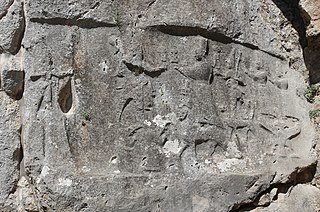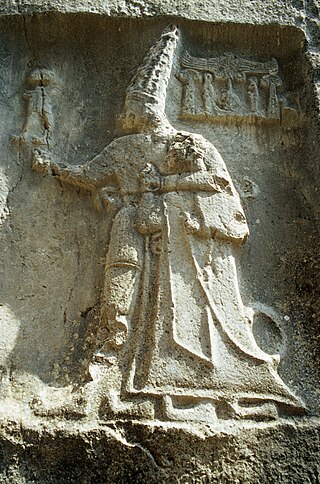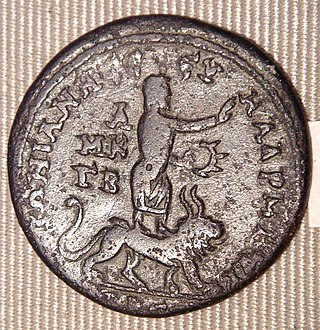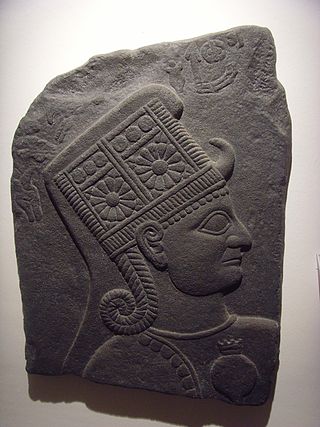Related Research Articles

Teshub was the Hurrian weather god, as well as the head of the Hurrian pantheon. The etymology of his name is uncertain, though it is agreed it can be classified as linguistically Hurrian. Both phonetic and logographic writings are attested. As a deity associated with the weather, Teshub could be portrayed both as destructive and protective. Individual weather phenomena, including winds, lightning, thunder and rain, could be described as his weapons. He was also believed to enable the growth of vegetation and create rivers and springs. His high position in Hurrian religion reflected the widespread importance of weather gods in northern Mesopotamia and nearby areas, where in contrast with the south agriculture relied primarily on rainfall rather than irrigation. It was believed that his authority extended to both mortal and other gods, both on earth and in heaven. However, the sea and the underworld were not under his control. Depictions of Teshub are rare, though it is agreed he was typically portrayed as an armed, bearded figure, sometimes holding a bundle of lightning. One such example is known from Yazılıkaya. In some cases, he was depicted driving in a chariot drawn by two sacred bulls.

Šarruma, also romanized as Šarrumma or Sharruma, was a Hurrian god. He could be depicted in both anthropomorphic form, sometimes riding on the back of a leopard, and in the theriomorphic form as a bull. His character is not fully understood, though it is known that he could function as a mountain god. He was regarded as a son of Ḫepat and Teshub. He was also linked to various moon deities. Additionally, the only mythological text he appears in addresses him as a messenger (sukkalu) of Kumarbi. He was worshiped by Hurrians in southeastern Anatolia and northern Syria, for example in Kummanni and Lawazantiya in Kizzuwatna. From this kingdom he was introduced to the Hittite pantheon as well. Hittite influence in turn resulted in his introduction to cities such as Aleppo, Emar and Ugarit. He was also venerated in Luwian religion in the first millennium BCE, with theophoric names invoking him attested from as late as the Hellenistic period in Cilicia and Lycia.

Ḫepat was a goddess associated with Aleppo, originally worshiped in the north of modern Syria in the third millennium BCE. Her name is often presumed to be either a feminine nisba referring to her connection to this city, or alternatively a derivative of the root ḫbb, "to love". Her best attested role is that of the spouse of various weather gods. She was already associated with Adad in Ebla and Aleppo in the third millennium BCE, and in later times they are attested as a couple in cities such as Alalakh and Emar. In Hurrian religion she instead came to be linked with Teshub, which in the first millennium BCE led to the development of a tradition in which she was the spouse of his Luwian counterpart Tarḫunz. Associations between her and numerous other deities are described in Hurrian ritual texts, where she heads her own kaluti, a type of offering lists dedicated to the circle of a specific deity. She commonly appears in them alongside her children, Šarruma, Allanzu and Kunzišalli. Her divine attendant was the goddess Takitu. In Hittite sources, she could sometimes be recognized as the counterpart of the Sun goddess of Arinna, though their respective roles were distinct and most likely this theological conception only had limited recognition. In Ugarit the local goddess Pidray could be considered analogous to her instead.
Kamrušepa was a Hittite and Luwian goddess of medicine and magic, analogous to Hattic and Palaic goddess Kataḫzipuri. She is best known as one of the deities involved in the Telepinu Myth, in which her actions were crucial to pacify the anger of the "missing" vegetation god.
Pirwa, also known under the variant names Perwa and Peruwa, was a god worshiped by Hittites and Luwians in ancient Anatolia. He was associated with horses. There is also evidence that he was regarded as a warlike deity. He is first attested in documents from Kanesh, which mention a priest in his service. He retained his connection with this city in later sources, but he also came to be worshiped in a number of other locations, including Hattusa. A possible late reference to him occurs in a Neo-Assyrian text listing deities worshiped in Arbela, though this attestation remains uncertain and might be a scribal mistake.

Ishara (Išḫara) was a goddess originally worshipped in Ebla and other nearby settlements in the north of modern Syria in the third millennium BCE. The origin of her name is disputed, and due to lack of evidence supporting Hurrian or Semitic etymologies it is sometimes assumed it might have originated in a linguistic substrate. In Ebla, she was considered the tutelary goddess of the royal family. An association between her and the city is preserved in a number of later sources from other sites as well. She was also associated with love, and in that role is attested further east in Mesopotamia as well. Multiple sources consider her the goddess of the institution of marriage, though she could be connected to erotic love as well, as evidenced by incantations. She was also linked to oaths and divination. She was associated with reptiles, especially mythical bašmu and ḫulmiẓẓu, and later on with scorpions as well, though it is not certain how this connection initially developed. In Mesopotamian art from the Kassite and Middle Babylonian periods she was only ever represented through her scorpion symbol rather than in anthropomorphic form. She was usually considered to be an unmarried and childless goddess, and she was associated with various deities in different time periods and locations. In Ebla, the middle Euphrates area and Mesopotamia she was closely connected with Ishtar due to their similar character, though they were not necessarily regarded as identical. In the Ur III period, Mesopotamians associated her with Dagan due to both of them being imported to Ur from the west. She was also linked to Ninkarrak. In Hurrian tradition she developed an association with Allani.

Nikkal or Nikkal-wa-Ib was a goddess worshiped in various areas of the ancient Near East west of Mesopotamia. She was derived from the Mesopotamian goddess Ningal, and like her forerunner was regarded as the spouse of a moon god, whose precise identity varied between locations. While well attested in Hurrian and Hittite sources, as well as in Ugarit, she is largely absent from documents from the western part of ancient Syria.
Manuzi was a mountain god worshiped in Kizzuwatna. He shared his name with the mountain he represented and with a village. He is best attested from sources pertaining to the hišuwa festival, which indicate he was the husband of the goddess Lelluri. He could be identified as a form of the Hurrian weather god Teshub as well, and as such was referred to as Teshub Manuzi.

Šanta (Santa) was a god worshiped in Bronze Age Anatolia by Luwians and Hittites. It is presumed that he was regarded as a warlike deity, and that he could additionally be associated with plagues and possibly with the underworld, though the latter proposal is not universally accepted. In known texts he frequently appears alongside Iyarri, a deity of similar character. He is first attested in documents from Kanesh dated to the Old Assyrian period, and continues to appear in later treaties, ritual texts and theophoric names. He is also present in an offering lists from Emar written in Akkadian, though he did not belong to the local pantheon and rituals involving him were only performed on behalf of the Hittite administration by local inhabitants.
Šuwaliyat was a Hittite god associated with vegetation. He was worshiped in Kanesh, Ḫupišna and Ḫunḫuišna, as well as in Hattusa. In a number of ritual texts he appears alongside the grain goddess Ḫalki. A close connection between him and the Hurrian god Tašmišu is also attested, and in Hittite adaptations of Hurrian myths and in other texts reflecting Hurrian influence his name could be used to designate his Hurrian counterpart.
Maliya was a goddess worshiped by Hittites in the Bronze Age. She was most likely a deified river in origin, but she was also associated with gardens and with artisanship, specifically with leatherworking and carpentry. The oldest attestations of her have been identified in the Old Assyrian texts from Kanesh. This city continued to be associated with her in later tradition, though she was also worshiped in Hattusa and elsewhere in the Hittite Empire. She is also present in texts originating in Kizzuwatna, which indicate she had a temple in Kummanni, where she was worshiped alongside various Hurrian deities.

Šimige was the Hurrian sun god. Known sources do not associate him with any specific location, but he is attested in documents from various settlements inhabited by the Hurrians, from Kizzuwatnean cities in modern Turkey, through Ugarit, Alalakh and Mari in Syria, to Nuzi, in antiquity a part of the kingdom of Arrapha in northeastern Iraq. His character was to a large degree based on his Mesopotamian counterpart Shamash, though they were not identical. Šimige was in turn an influence on the Hittite Sun god of Heaven and Luwian Tiwaz.

Kubaba was a goddess of uncertain origin worshiped in ancient Syria. Despite the similarity of her name to these of legendary queen Kubaba of Kish and Phrygian Cybele, she is considered a distinct figure from them both. Her character is poorly known. Multiple local traditions associating her with other deities existed, and they cannot necessarily be harmonized with each other. She is first documented in texts from Kanesh and Alalakh, though her main cult center was Carchemish. She was among the deities worshiped in northern Syria who were incorporated into Hurrian religion, and in Hurrian context she occurs in some of the Ugaritic texts. She was also incorporated into Hittite religion through Hurrian intermediaties. In the first millennium BCE she was worshiped by Luwians, Arameans and Lydians, and references to her can be found in a number of Greek texts.

Nabarbi or Nawarni was a Hurrian goddess possibly associated with pastures. She was one of the major deities in Hurrian religion, and was chiefly worshiped in the proximity of the river Khabur, especially in Taite. It has been proposed that she was associated with the goddess Belet Nagar, linked to the Upper Mesopotamian city of Nagar. In addition to being venerated in Hurrian religion, she was also incorporated into the beliefs of the Hittites and into the local pantheon of Emar. She also continued to be worshiped in Taite in the Neo-Assyrian period, as attested in a text from the reign of Ashurbanipal, where she is one of the deities invoked to bless the king.
Anna was the main deity of Kanesh, an Anatolian city which in the Old Assyrian period served as an Assyrian trading colony. Multiple possibilities regarding her origin have been considered by researchers. A temple, festivals and clergy dedicated to her are attested in texts from her city, and in contracts she appears alongside the Assyrian god Ashur. At some point her position declined, and an unidentified weather god became the main local deity instead. It is nonetheless assumed that she continued to be worshiped later on by Hittites and Luwians. It has also been proposed that a deity from Emar can be identified with her, though not all researchers share this view.
Karhuha (Karḫuḫa), also known as Karḫuḫi, was the tutelary god of the ancient city of Carchemish. He was associated with deer, and it is presumed his character was similar to that of Hittite Kurunta. He is first attested in texts from the second half of the second millennium BCE, and there is no agreement among researchers if he was a Hurrian god in origin or if similarly to closely associated goddess Kubaba he predated Hurrian control over the region. He appears in a variety of Hittite and Luwian texts, and continued to be worshiped through the first millennium BCE.
Ḫalki was the Hittite deity of grain. While it is commonly assumed the name consistently referred to a goddess, a male form of this deity has also been identified. Ḫalki was associated with other grain deities, namely Mesopotamian Nisaba and Hattian Kait, with the latter presumed to be functionally identical. The oldest attestations come from Kanesh, though they are limited to theophoric names. In later periods, the female form of Ḫalki was worshiped in Hattusa, and the male one in Nerik, though evidence from other cities is also available.
Šulinkatte was a Hittite god of Hattian origin. He was regarded as a war deity. Additionally, he could fulfill the role of a protector of palaces and houses. In the local tradition of Nerik, he was regarded as the father of the weather god of Nerik. He first appears in texts dated to the fifteenth or fourteenth century BCE. His main cult center was the sparsely attested city Tamarmara, but he was also worshiped elsewhere in ancient Anatolia, for example in Hattusa and Nerik. Fragments of a Hattic song celebrating him are also known.
Iyaya was a Hittite and Luwian goddess. Her functions remain uncertain, though it has been suggested she was associated with water or more broadly with nature. She might have been associated with the god Šanta, though the available evidence is limited. Her main cult centers were Lapana and Tiura, though she was also worshiped in other cities.
Aškašepa was a Hittite deity presumed to be a deified mountain, possibly Mount Erciyes. He is first attested in a treaty from Kanesh, and continued to be regarded as one of the deities associated with this city in later sources. He was worshiped in cities such as Hattusa, Ištanuwa and Karaḫna. He also appears in a number of international treaties between the rulers of the Hittite Empire and other contemporary monarchs as one of the invoked divine witnesses.
References
- ↑ Cammarosano 2015, p. 206.
- 1 2 3 Taracha 2009, p. 98.
- 1 2 3 4 5 6 7 Haas 2015, p. 369.
- 1 2 Millington 2013, p. 548.
- ↑ Taracha 2009, p. 100.
- ↑ Taracha 2009, p. 117.
- 1 2 3 Taracha 2009, p. 113.
- 1 2 3 Millington 2013, p. 551.
- ↑ Millington 2013, p. 550.
- 1 2 3 Archi 2010, p. 21.
- ↑ Haas 2015, p. 376.
- ↑ Haas 2015, p. 301.
- ↑ Schwemer 2022, p. 380.
- ↑ Taracha 2009, p. 86.
- 1 2 3 Haas 2015, p. 368.
- ↑ Archi 2010, p. 24.
- ↑ Raimond 2007, p. 156.
- ↑ Millington 2013, p. 545-546.
- ↑ Millington 2013, p. 546.
- ↑ Wiggermann 1998, p. 217.
- ↑ Millington 2013, pp. 547–548.
- ↑ Millington 2013, p. 552.
- ↑ Millington 2013, pp. 553–554.
- ↑ Millington 2013, p. 560.
- ↑ Millington 2013, p. 557.
- 1 2 3 Archi 2010, p. 25.
- ↑ Taracha 2009, p. 107.
- ↑ Taracha 2009, p. 116.
- ↑ Millington 2013, p. 549.
- 1 2 Millington 2013, pp. 559–560.
- ↑ Millington 2013, p. 559.
Bibliography
- Archi, Alfonso (2010). "The Heptad in Anatolia". In Lebrun, René (ed.). Studia Anatolica in memoriam Erich Neu dicata. Louvain-la-Neuve: Peeters. ISBN 978-90-429-2338-6. OCLC 682137206.
- Cammarosano, Michele (2015). "Foreign Gods in Hatti. A New Edition of CTH 510". KASKAL. Rivista di storia, ambienti e culture del Vicino Oriente Antico. Firenze: LoGisma editore. 12. ISSN 1971-8608.
- Haas, Volkert (2015) [1994]. Geschichte der hethitischen Religion. Handbook of Oriental Studies. Section 1: The Near and Middle East (in German). Brill. ISBN 978-90-04-29394-6 . Retrieved 2022-11-22.
- Millington, Alexander T. (2013). "Iyarri at the Interface: The Origins of Ares". In Mouton, Alice; Rutherford, Ian; Yakubovich, Ilya S. (eds.). Luwian identities: culture, language and religion between Anatolia and the Aegean. Boston: Brill. pp. 543–565. doi:10.1163/9789004253414_020. ISBN 978-90-04-25341-4. OCLC 851081843.
- Raimond, Eric A. (2007). "Hellenization and Lycian Cults During the Achaemenid Period". In Tuplin, Christopher (ed.). Persian Responses: Political and Cultural Interaction with(in) the Achaemenid Empire. The Classical Press of Wales. doi:10.2307/j.ctvvnb3j.12.
- Schwemer, Daniel (2022). "Religion and Power". Handbook of Hittite Empire. De Gruyter. pp. 355–418. doi:10.1515/9783110661781-009. ISBN 9783110661781.
- Taracha, Piotr (2009). Religions of Second Millennium Anatolia. Dresdner Beiträge zur Hethitologie. Vol. 27. Wiesbaden: Harrassowitz Verlag. ISBN 978-3447058858.
- Wiggermann, Frans A. M. (1998), "Nergal A. Philological", Reallexikon der Assyriologie, retrieved 2022-11-23